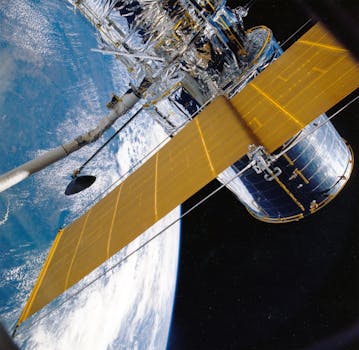
GEO Satellites: Understanding the Technology and Applications
GEO satellites, or Geostationary Earth Orbit satellites, are a type of satellite that orbits the Earth at an altitude of approximately 36,000 kilometers. They are stationed above the equator and remain fixed in relation to a specific point on the Earth’s surface, allowing them to provide continuous coverage of a particular region. GEO satellites play a crucial role in modern telecommunications, providing global coverage and enabling a wide range of applications, including television broadcasting, telecommunications, and weather forecasting.
GEO satellites are equipped with transponders, which are devices that receive and retransmit signals. These signals are transmitted to the satellite from a ground station, and then retransmitted back to Earth, where they can be received by a variety of devices, including television sets, mobile phones, and computers. The signals transmitted by GEO satellites are typically in the C-band, Ku-band, or Ka-band frequency ranges, which are allocated for satellite communications.
Applications of GEO Satellites
GEO satellites have a wide range of applications, including television broadcasting, telecommunications, and weather forecasting. They are also used for navigation, remote sensing, and scientific research. One of the most significant applications of GEO satellites is in the field of telecommunications, where they are used to provide internet connectivity, mobile phone coverage, and other communication services to remote and underserved areas.
GEO satellites are also used for television broadcasting, allowing channels to be transmitted globally. They are used by news organizations to transmit live footage, and by sports organizations to broadcast live events. In addition, GEO satellites are used for weather forecasting, providing images of the Earth’s atmosphere and oceans that are used to predict weather patterns.
Technological Advancements in GEO Satellites
In recent years, there have been significant technological advancements in GEO satellites, including the development of more powerful and efficient transponders, and the use of advanced materials and designs to reduce the weight and increase the lifespan of satellites. These advancements have enabled the development of smaller, more efficient satellites that can provide more services and applications.
Another significant technological advancement in GEO satellites is the use of electric propulsion systems, which provide more efficient and longer-lasting propulsion than traditional chemical propulsion systems. Electric propulsion systems use electricity to accelerate ions or neutral particles, providing a high specific impulse and a longer mission duration.
Future of GEO Satellites
The future of GEO satellites is promising, with a growing demand for satellite-based services and applications. The development of new technologies, such as advanced propulsion systems and more efficient transponders, will enable the creation of more powerful and capable satellites. In addition, the increasing use of satellite-based services, such as satellite internet and mobile phone coverage, will drive the demand for more GEO satellites.
However, the future of GEO satellites also poses significant challenges, including the increasing competition from other types of satellites, such as Low Earth Orbit (LEO) satellites, and the need to address issues related to space debris and satellite congestion. To address these challenges, satellite operators and manufacturers will need to develop more efficient and sustainable satellites, and to work with regulatory bodies to establish clear guidelines and regulations for the use of GEO satellites.